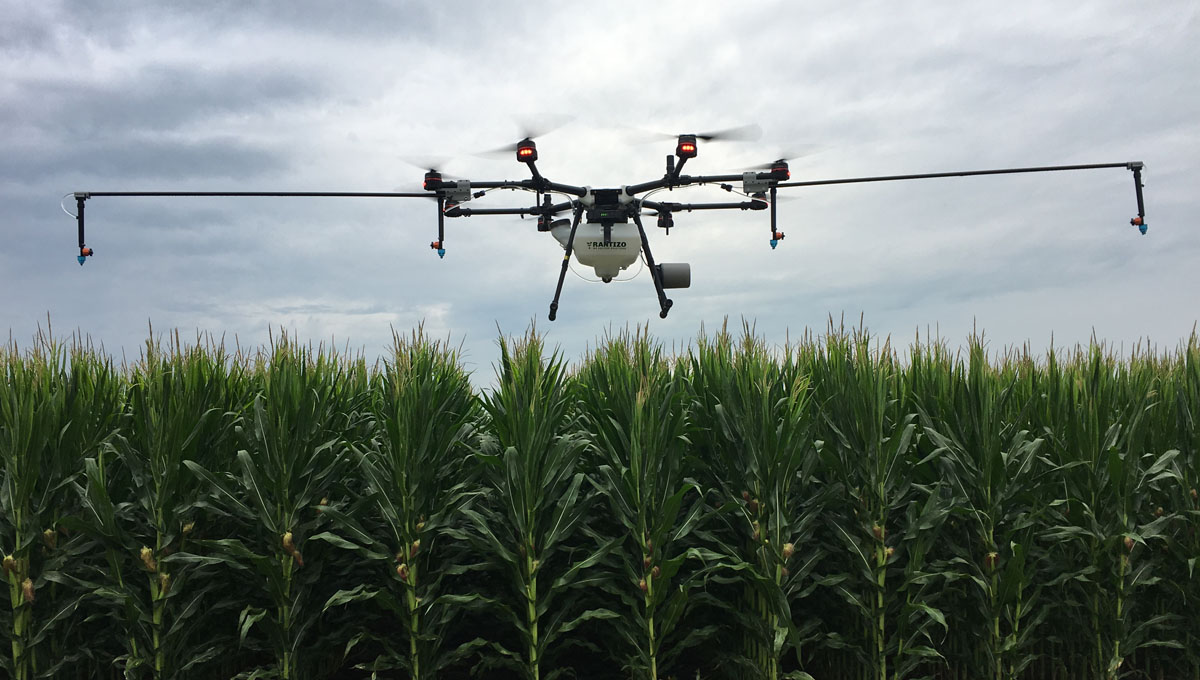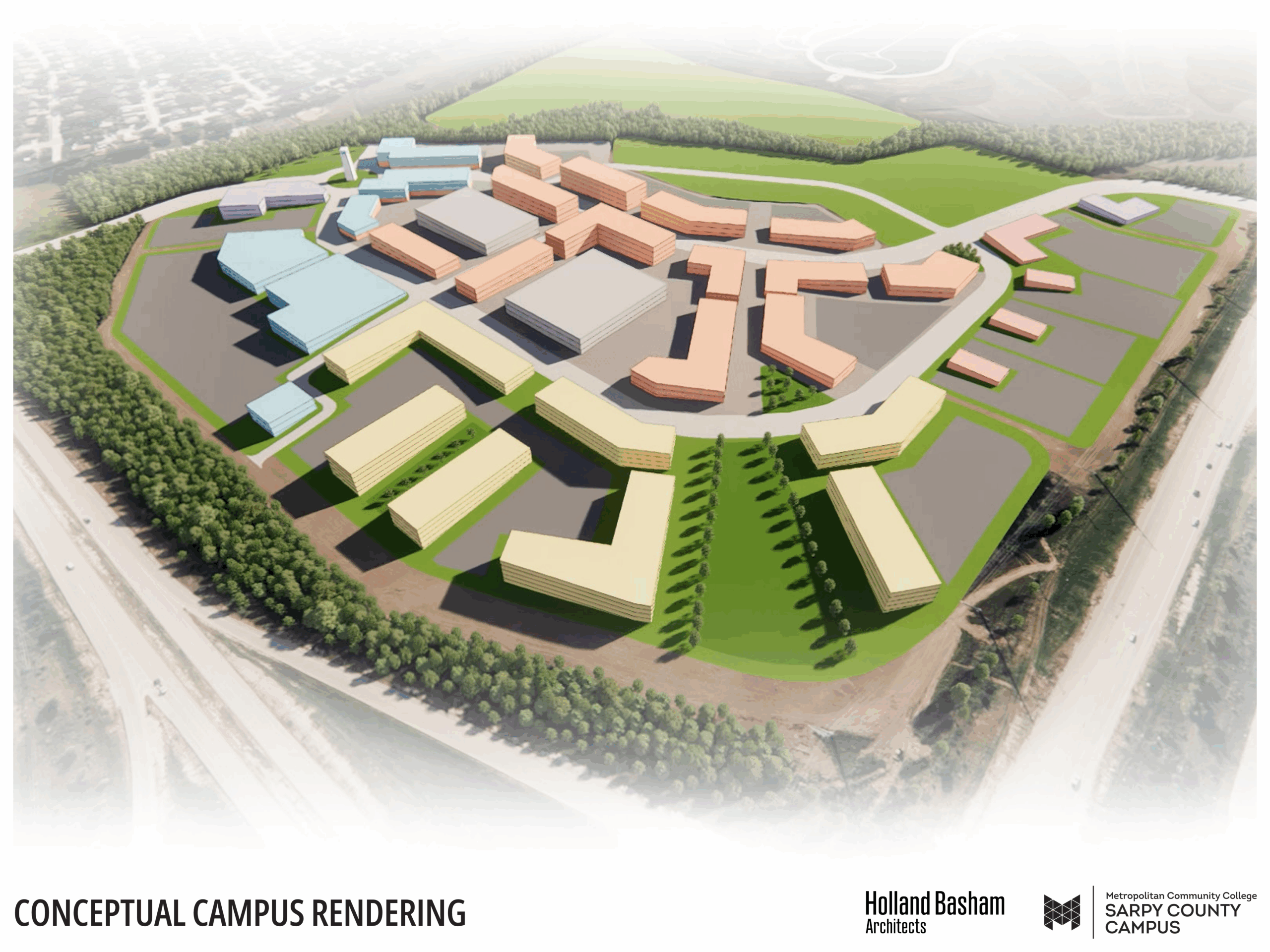On its own, a corn plant will pollinate itself: the golden tassels topping the slender green shoots that comprise nearly one-third of U.S. cropland naturally release pollen that fertilizes the silky portion of the plant below. This natural process is critical to the country’s number-one feed crop, but experts say fertilization must be facilitated to preserve the traits that allow today’s corn hybrids to withstand disease, pests and eye-popping yields.
A just-announced $7.5 million Series A infusion of venture capital will help support a brand-new method of pollinating corn developed by Iowa City-based agtech company Rantizo.
As far as Rantizo CEO Michael Ott knows, his company is the only one to have used drone technology to pollinate corn. Rantizo’s innovative approach to drone-assisted application of products like pesticides, herbicides, fertilizers, and seeds has captured the attention—and venture funding—of investors from the cotton capital of Memphis to Leaps by Bayer, the impact investment arm of German life sciences juggernaut Bayer AG.
“Many strategic players are evaluating their options for the future and trying to evolve their businesses where the markets will go, rather than just focusing on what they have already done,” Ott told Silicon Prairie News from the National Agricultural Aviation Association’s annual conference in Savannah, Georgia.
“We’ve been able to bring in strategic partners (like Leaps by Bayer) that see the vision for a future that’s different from what they’re currently doing, and they wanted to be prepared for that,” Ott said.
The pollination-by-drone approach is the company’s newest development; this latest round of funding prioritizes expansion of Rantizo’s salesforce first, a more robust data infrastructure second, and the pollination-by-drone play third. To date, the company has attracted nearly $9 million in venture funding.
Drone-assisted application of farm chemicals and seeds is the subject of numerous academic, industry, and government studies. Already, drones are in use as means of reforesting areas scorched by wildfire and monitoring and herding livestock. The U.S. Environmental Protection Agency’s Office of Pesticide Programs in June was reported to be in discussions about bringing multiple EPA working groups together to further discuss pesticide-related protocol around drones.
For its part, the National Agricultural Aviation Association considers drones a “complementary tool to manned aerial application methods, not a wholesale replacement,” trade group head Andrew Moore wrote in a May 2019 column. The NAAA—which represents crop dusters as an industry and counts about 1,900 members in 46 states—estimates pilots of manned aircraft treat approximately 127 million acres of cropland every year, or 28% of all U.S. commercial cropland.
But despite manned aircraft’s relative advantages in terms of speed and payload, Ott points to drones’ extreme precision when it comes to applying farm chemicals exactly where they’re needed—thanks in part to the company’s partnership and integration with imagery companies.
“If you’ve got a weed issue, an insect issue, and fertilizer deficiency, the current approach is to load a batch of herbicide, insecticide, and micronutrients and put gallons of materials down across the entire field. That works, but you’re also spraying insecticide in areas where you have micronutrient deficiency, and you’re spraying herbicide on insects. You’re doing what you need to do, but you’re wasting a lot of chemicals,” Ott said. “Now, we can drop insecticide on insects, herbicide on weeds, and micronutrients where you’re deficient in fertilizer. We’re within an inch of where we need to be at all times, (whereas) with a standard system, we’re within a yard.”
That kind of precision could play a critical part in improving the efficiency of agrichemical application on farms at a time where nutrient runoff is becoming particularly problematic for Midwestern cities that have been increasingly active in combating issues related to farm and feedlot runoff.
Des Moines Water Works leaders in August warned that the Des Moines River was “essentially unusable” as a drinking water source for half a million Iowans due to toxic byproducts from fertilizer- and manure-fed algae that thrived in the waterway. A report from the Environmental Working Group cited by the Iowa Capital Dispatch in its Water Works reporting stated that algae toxin-related responses have cost U.S. communities over $1.1 billion in the last 10 years. Add to those issues the association of high nitrate concentration with assorted illness and infant mortality, and Rantizo’s value proposition becomes even more clear.
“Rantizo’s platform has the potential to have a lot of impact in this field,” said Jürgen Eckhardt, Head of Leaps by Bayer, in a statement announcing the Rantizo investment. “It allows for precision pest control while reducing soil compaction, leading to more breathable land and reduces carbon emission from traditional sprayers all while enabling improved farmer profitability. This is better for the crop, better for the land, and better for the farmer, leading us towards a more sustainable food supply.”
Rantizo received certification from the state of Iowa to legally operate drones for aerial application of agri-chemicals in July 2019, making it the first company in the state to receive such permission. Its technology was ready for the market earlier in 2019, and it received the required approvals from the Federal Aviation Administration in May 2019. Since then, it has received regulatory approvals to fly in 15 states between the west coast and Pennsylvania—and it also has a federal exemption that enables it to operate three drones simultaneously.
Ott said three is the proverbial magic number for now “because that’s about as many as you can reload in a reasonable time frame” using Rantizo’s proprietary autonomous reloading device; “swarming,” as the practice of operating multiple drones simultaneously is referred to, still helps increase efficiency over a single drone.
So, what does this all mean on Midwestern farms, where corn is king?
Year after year of bin-busting corn yields make it the top cash crop in the U.S., with forecasted cash receipts of approximately $47 billion for the 2020 harvest. But despite comprising nearly 13% of forecasted cash receipts for all U.S. commodities in 2020, volatile per-bushel corn prices earlier this year traded at lows not seen since the Great Recession. Prices have since rebounded, but it’s still no walk in the park for producers like Ben Riensche, a northeast Iowa farm owner.
“The current row crop production model no longer has much, if any margin to it. Machine costs are simply too high and most innovation is just focused on producing more yield, not necessarily more profit,” Riensche said.
Riensche’s Jesup, Iowa-based Blue Diamond Farming Company leveraged Rantizo technology for aerial agrichemical application and for seeding of cover crops. For him, the benefits speak for themselves: “Rantizo gives me an opportunity to apply crop care products with a fraction of the investment of a large commercial sprayer. Also, aerial seeding of cover crops will place me in the perfect spot to participate in the rapidly developing carbon sequestration marketplace, as well as simply be a better steward of the land.”




